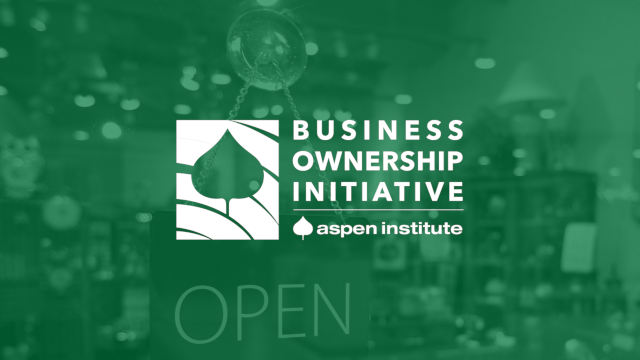From the Black Lives Matter movement, to the pandemic, to the election, the year’s events have put systemic inequality front and center. The persistent and growing racial wealth gap, long-standing disparities in access to opportunity, and the disproportionate impact of the pandemic on small businesses owned by people of color have rightfully received a lot of attention.
However, recognizing those problems doesn’t tell us what to do about them. The Institute’s Economic Opportunities Program and Business Ownership Initiative have been working on some of these issues for decades. One of the thorniest problems we are still tackling is how to get more capital to small businesses owned by women and people of color in low-income communities.
Businesses started and owned by entrepreneurs of color tend to be smaller and in less profitable industries, because of the effects of systemic inequality and racism. These entrepreneurs cannot rely on personal or familial wealth nor can they get external financing which is often tied to personal assets. They have to start small and slowly work their way up. That means that when they do apply for financing, they tend to be looking for smaller amounts of capital—the vast majority apply for less than $100,000, and many seek less than $25,000. That is not because these entrepreneurs don’t dream big, it’s because they understand what their business can use and how much they can afford to borrow.
However, the reality of lending to small businesses is that it is very, very difficult to make loans under $100,000 at affordable rates and turn a meaningful profit. Finding, qualifying, underwriting, and supporting those businesses just costs too much compared to the interest earned. Small business lending from banks in amounts less than $100,000 has been dropping for decades, especially since the 2008 recession. We expect it will decline more as a result of the pandemic.
These economics don’t just affect banks. Fintech lenders using the latest technology either target borrowers with high credit scores or price their loans at 35% APR or more (sometimes 10 times that). And even Community Development Finance Institutions (CDFIs) face significant challenges in making these loans at the volume necessary to move meaningful amounts of capital into these communities.
Small business loans of less than $50,000 in the US are termed “microloans.” There are only a few institutions that will make microloans to small businesses at affordable rates and target entrepreneurs of color and women: CDFI microlenders. To do so, CDFI microlenders like the ones that make up the Microfinance Impact Collaborative (hosted by Aspen’s Business Ownership Initiative) have to raise capital to lend, but also to subsidize their operating costs. The number of entrepreneurs of color they can serve depends on how much they can raise in grant funding.
That’s a challenge even in good economic times. In the pandemic, when the businesses they serve are struggling most, the CDFI microlenders have done the right thing: worked with their borrowers to keep them in business, deferred loan payments, and offered even more support. But without loan repayments, the lenders are even more dependent on grants and other philanthropic support.
Introducing the Entrepreneur-Backed Assets Fund. The EBA Fund, with support from the Citi Foundation, the Bill & Melinda Gates Foundation, the Robert Wood Johnson Foundation, Microsoft, and Woodforest National Bank, will allow Community Development Finance Institutions that are already active lenders to entrepreneurs of color to provide more capital and support to those communities, right when the need is greatest.
The Fund will allow these lenders to extend more capital to hard-hit businesses and communities by buying existing loans from the lenders. That puts capital back into the hands of the lenders, which they can turn around and lend to other businesses instead of waiting for their existing loans to be repaid. Meanwhile, the EBA Fund will sell the loans it buys on to commercial banks or other investors who are interested in the Community Reinvestment Act credits that lending to low-income communities can provide. The “clearinghouse” for buying these loans will make the process of loan sales much more efficient for microlenders selling loans and for banks buying loans, ultimately significantly boosting the amount of capital that gets to entrepreneurs who need it most.
Built by and with organizations with deep experience in lending to entrepreneurs of color and into low-income communities, the EBA Fund launched with initial grant funding from the Citi Foundation, the Bill & Melinda Gates Foundation, and the Robert Wood Johnson Foundation. Microsoft Corporation and Woodforest National Bank are making the first capital investments in the Fund. The $8.75M in founding commitments now in place put the Fund on pace to purchase 1,000 small business loans by February of 2021, positioning the CDFIs to lend at a time when extending capital to small businesses will be critical to ensure an equitable recovery from the pandemic. We will continue to raise more funding—with a goal of $50 million— which we will put to work by buying more loans from more lenders so that more capital gets into the hands of entrepreneurs of color. Because everyone deserves to dream bigger.
Joyce Klein is the Director of the Business Ownership Initiative at the Aspen Institute Economic Opportunities Program.
Timothy Ogden is the Managing Director of the Financial Access Initiative at NYU-Wagner, and a Senior Fellow of the Aspen Institute’s Economic Opportunities and Financial Security Programs.


